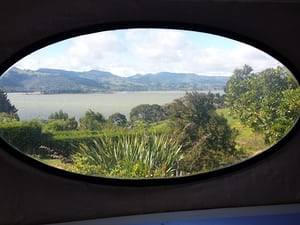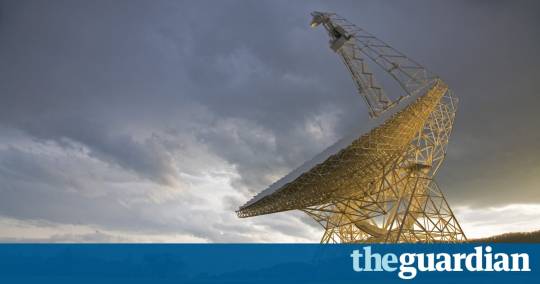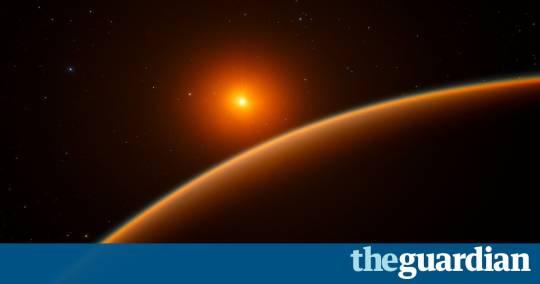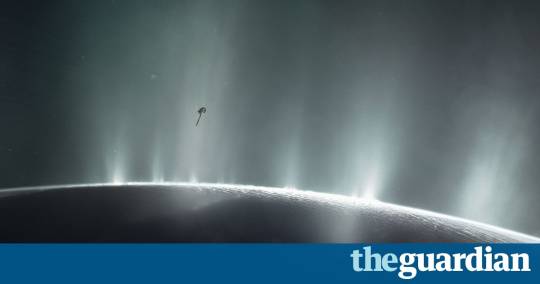Latest Alient & UFO Pictures, Videos and Stories.Google+Official Site
Don't wanna be here? Send us removal request.
Text
Weird world: Titanium spied in giant alien planet’s skies
For the first time ever, titanium oxide has been spotted in an exoplanet’s skies, a new study reports.
Astronomers using the European Southern Observatory’s Very Large Telescope (VLT) in Chile detected the substance in the atmosphere of WASP-19b, a huge, scorching-hot planet located 815 light-years from Earth.
“The presence of titanium oxide in the atmosphere of WASP-19b can have substantial effects on the atmospheric temperature structure and circulation,” study co-author Ryan MacDonald, an astronomer at the University of Cambridge in England, said in a statement. [The Strangest Alien Planets (Gallery)]
One possible effect is “thermal inversion.” If enough titanium oxide is present, the stuff can keep heat from entering or exiting an atmosphere, causing upper layers to be hotter than lower layers, researchers said. (This phenomenon occurs in Earth’s stratosphere, but the culprit is ozone, not titanium oxide.)
More From Space.com
Very Large Telescope external-ct
Read more: http://www.foxnews.com/
The post Weird world: Titanium spied in giant alien planet’s skies appeared first on AlienVirals.com - Latest Alien & UFO News.
from AlienVirals.com – Latest Alien & UFO News http://www.alienvirals.com/weird-world-titanium-spied-in-giant-alien-planets-skies/
0 notes
Text
Bannon on Catholic Church’s DACA support: ‘They need illegal aliens to fill the churches’
Washington (CNN)Former White House chief strategist Steven Bannon said the Catholic Church’s support of the Deferred Action for Childhood Arrivals program, known as DACA, is economically driven and owes to the church’s struggle to fill pews.
“To come to grips with the problems in the church, they need illegal aliens. They need illegal aliens to fill the churches. It’s obvious on the face of it,” Bannon said in a “60 Minutes” interview that was previewed on “CBS This Morning” Thursday. “They have an economic interest in unlimited immigration.”
Bannon, a Catholic, downplayed the church’s opinions on DACA, arguing that they carry little weight and saying the church was “just another guy with an opinion.”
“As much as I respect Cardinal (Timothy) Dolan and the bishops on doctrine, this is not doctrine. This is not doctrine at all. I totally respect the Pope and I totally respect the Catholic bishops and cardinals on doctrine. This is not about doctrine. This is about the sovereignty of a nation,” Bannon said.
The US Conference of Catholic Bishops called the repeal of DACA “unacceptable” in a statement Tuesday.
DACA debate could send a political shockwave through 2018 and beyond
“The cancellation of the DACA program is reprehensible. It causes unnecessary fear for DACA youth and their families. These youth entered the U.S. as minors and often know America as their only home,” the statement read.
President Donald Trump formally announced on Tuesday the end of DACA — a program first enacted under President Barack Obama that had protected nearly 800,000 young undocumented immigrants brought to the US as children from deportation.
Trump’s decision to end the program was met with criticism on both sides of the aisle.
Bannon said in the interview that he did not agree with Trump’s decision on DACA but said he “understood how he struggled with it.” Bannon added that he’s aware that conservatives and people on the far-right are not happy with Trump’s decision.
The clip aired on Thursday did not provide further context about why Bannon disagreed with DACA.
Trump fired Bannon mid-August amid a reshuffling of power within his administration. He has since returned to his role as executive chairman at Breitbart News.
Read more: http://edition.cnn.com/
The post Bannon on Catholic Church’s DACA support: ‘They need illegal aliens to fill the churches’ appeared first on AlienVirals.com - Latest Alien & UFO News.
from AlienVirals.com – Latest Alien & UFO News http://www.alienvirals.com/bannon-on-catholic-churchs-daca-support-they-need-illegal-aliens-to-fill-the-churches/
0 notes
Text
‘UFO’ spotted over California’s San Gabriel Valley?
A YouTube video on the mysterious object has gone viral, but there may be a terrestrial explanation for the ‘UFO’.
The video, posted by Julian Lopez, appears to show a Los Angeles County Sheriff’s Department helicopter circling around an unidentified flying object, which some observers say may be an advertisement for marijuana products.
Fox 11 reports that the object was seen floating over the San Gabriel Valley on the morning of Aug. 28.
On the video, Lopez can be heard saying: “A helicopter is circling it. It looks like a big eyeball.”
MINING COMPLEX ON THE MOON? UFO HUNTER CLAIMS STRUCTURES VISIBLE ON LUNAR SURFACE
Other witnesses (as reported by the Pasadena Star News) reported seeing a large, white advertising ballon for a company known as “Brass Knuckles.” Brass Knuckles is described as “the industry leader in Super Premium CO2 extracted cannabis oil products,” according to a medical marijuana website.
Lopez’ video has attracted significant interest on social media, gathering nearly 300,000 views.
One commenter wrote: “[A]t that altitude a balloon would be long gone – this is a powered craft it is the only way it could hold a stationary position.”
Another commenter, user name al gonzalez, wrote: “This is great capture.”
REPORTS CLAIM UFO WHIZZES PAST INTERNATIONAL SPACE STATION
SecureTeam10, a YouTube channel known for its conspiracy theory videos, has mentioned the unidentified object in one of its recent videos.
Read more: http://www.foxnews.com/
The post ‘UFO’ spotted over California’s San Gabriel Valley? appeared first on AlienVirals.com - Latest Alien & UFO News.
from AlienVirals.com – Latest Alien & UFO News http://www.alienvirals.com/ufo-spotted-over-californias-san-gabriel-valley/
0 notes
Text
Need more space? UFO-shaped home goes up for sale in New Zealand
The Futuro house, complete with built-in furniture and a spaceship-style entrance, is one of only about 100 ever built

A rare spaceship-shaped home has been put for sale in New Zealand, attracting international interest as sci-fi and architecture nerds scramble to secure a UFO abode by the sea.
Futuro houses were created in 1968 by Finnish architect Matti Suuronen as pre-fab, portable ski chalets. Shaped like an egg and constructed from fibreglass-reinforced polyester plastic the unusual houses became cult designs, with less than 100 ever produced.
There is something magical about the shape of an egg, its smoothness and strength and the spaceship is like that; it is an iconic shape that attracts you to it, says Juanita Clearwater, an architectural designer, who is selling her beloved Futuro.
Futuros get under your skin, it is like an adult treehouse.

The interior of the home, which has in-built furniture. Photograph: Juanita Clearwater
Clearwater bought her Futuro, which features built-in furniture and a spaceship-style hatch entrance, four years ago as a holiday home in the small coastal village of Warrington in the south island of New Zealand. Combining her love of sci-fi with 1960s architecture, owning one was a life-long dream.
Whenever the Clearwater family arrive at their spaceship for a holiday theyre met by notes and messages tucked into the door and post-box from strangers asking to buy the house or take a peek inside. A geo-cache has also been planted just outside, drawing more casual adventurers to its orbit.
There has been constant interest and we welcome that but it is also a home, not just a work of art. And it functions very well as a home.
Clearwaters futuro was one of 12 built in Christchurch under licence and was displayed at the 1974 Commonwealth games before being transported to Warrington in 1975.
The house has not been moved since, and Clearwater is determined to only sell to a buyer who will keep it insitu and preserve its unique features and charm.
As a soon-to-be empty nester, Clearwater is selling reluctantly because she feels that holding onto it for increasingly occasional visits is selfish. Transporting the home by barge or helicopter to Christchurch has been considered, she said, but it would mean ending its long association with Warrington.

The view from the home in Warrington, New Zealand. Photograph: Juanita Clearwater
There are a lot in America that have been let go to disgraceful conditions and theyve just become rubbish. The good thing about the ones in New Zealand is that we like to preserve what history weve got.
Since posting the house on Trade Me on Monday Clearwater has been overwhelmed with interest, and she was considering 40 serious offers. The for-sale page has been viewed 18,000 times, with Clearwater looking for around NZ$400,000 (220,000 or US$289,000) though the buyers intentions would be more important than the money.
It has been beautifully preserved and is probably the best ship in New Zealand and in the best location, she says.
I want it to go to someone who, like me, has wanted one their whole life. It is time to pass it on.
Read more: http://www.theguardian.com/us
The post Need more space? UFO-shaped home goes up for sale in New Zealand appeared first on AlienVirals.com - Latest Alien & UFO News.
from AlienVirals.com – Latest Alien & UFO News http://www.alienvirals.com/need-more-space-ufo-shaped-home-goes-up-for-sale-in-new-zealand/
0 notes
Text
Alien search detects radio signals from dwarf galaxy 3bn light years from Earth
Stephen Hawkings Breakthrough Listen project picks up radio pulses that could be from black holes, neutron stars or, some speculate UFO beacons

Astronomers searching for signals from alien civilisations have detected 15 powerful, repeated radio pulses coming from a dwarf galaxy 3 billion light years away from Earth.
The source of the mysterious signals, known as fast radio bursts, is unknown. Some have proposed they could be emanating from black holes or rotating neutron stars with extremely strong magnetic fields. A more speculative possibility is that they are beacons from extraterrestrial spacecraft.
The signals were picked up by the Breakthrough Listen project, a $100m (77m) initiative to find signs of intelligent life in the universe set up by Professor Stephen Hawking and Russian internet billionaire Yuri Milner.
About two dozen fast radio bursts have been detected previously. Because they last only a few milliseconds and radio telescopes can only monitor a small area of the sky at any given time, only one of these sources has been observed to repeat.
The source, known as FRB 121102, was discovered in 2012 and resides in a dwarf galaxy about 3bn light years from Earth.
Now 15 more signals have been observed from the same source and at a higher frequency than the previous signals although what this signifies about the source of these mysterious events is not yet clear.
As well as confirming that the source is in a newly active state, the high resolution of the data obtained by the Listen instrument will allow measurement of the properties of these mysterious bursts at a higher precision than ever possible before, said Breakthrough Listen postdoctoral researcher Vishal Gajjar, who discovered the increased activity.
Andrew Siemion, director of the Berkeley SETI Research Center and of the Breakthrough Listen programme, said: Whether or not fast radio bursts turn out to be signatures of extraterrestrial technology, Breakthrough Listen is helping to push the frontiers of a new and rapidly growing area of our understanding of the universe around us.
The findings were reported on the Astronomers Telegram website.
Read more: http://www.theguardian.com/us
The post Alien search detects radio signals from dwarf galaxy 3bn light years from Earth appeared first on AlienVirals.com - Latest Alien & UFO News.
from AlienVirals.com – Latest Alien & UFO News http://www.alienvirals.com/alien-search-detects-radio-signals-from-dwarf-galaxy-3bn-light-years-from-earth/
1 note
·
View note
Text
NASA Says Saturn’s Icy Moon Enceladus Could Harbor Alien Life
Saturns icy moon Enceladus could theoretically be home to methane-producing alien life, NASA said Thursday.
Researchers made the announcement based on data from 2015, when the spacecraft Cassini detected the presence of hydrogen during a flyby through a plume of gas and ice erupting from Enceladus south pole. The hydrogen, which is escaping into space from a hydrothermal vent on the moons seafloor, could be a sign of methanogenesis, a form of anaerobic respiration in which microbes produce methane.
This is a very significant finding because the hydrogen could be a potential source of chemical energy for any microbes that might be in Enceladus ocean,Linda Spilker, a scientist at NASAs Jet Propulsion Laboratory, said Thursday at a press conference.
We now know that Enceladus has almost all of the ingredients you would need to support life as we know it on Earth, she said.
The findings were published Thursday in the journal Science.
NASA/JPL Caltech
This is the closest weve come, so far, to identifying a place with some of the ingredients needed for a habitable environment, Thomas Zurbuchen, associate administrator for NASAs Science Mission Directorate, said in a statement. These results demonstrate the interconnected nature of NASAs science missions that are getting us closer to answering whether we are indeed alone or not.
NASA also announced that the Hubble Space Telescope observed what may have been a water vapor plume emerging from the surface of Jupiters moon Europa in 2014, and again around the same area in 2016.
Confirming the existence of Europas plumes would allow researchers to study that moons chemical makeup without having to dig through miles of icy crust.
The Cassini and Hubble discoveries related to theseocean worlds will help scientists plan NASAs Europa Clipper mission, set to launch in the 2020s. The plan is for the unmanned spacecraft to orbit Jupiter and perform a detailed investigation of Europa, including measuring the depth and salinity of its ocean.
These discoveries are coming just at the perfect time,Jim Green, director of NASAs Planetary Science Division, said Thursday. It enables us to make the right set of observations that can tell us much more about these ocean worlds, Europa in particular.
In February, NASA announced it had discovered a treasure troveof Earth-sized planets orbiting a nearby dwarf star. Three of the seven newly discovered planets lie in the so-called Goldilocks zone, meaning they are the right distance from the star they orbit to possibly harbor water, or even life.
The agency is refocusing on deep space exploration under President Donald Trump, who signed a bill into law last month that authorized federal funding for NASAs 2018 budget year and added human exploration of Mars as an agency objective.
This story has been updated with additional comments from NASA researchers. Language has also been amended to clarify the nature of methanogenesis.
Related…
Donald Trump Signs Bill Authorizing NASA Budget, Mars Exploration
Scientists Discover 'Treasure Trove' Of Earth-Sized Planets Orbiting Nearby Dwarf Star
GOP Wants NASA To Stop Worrying About Earth And Focus On Space
Read more: http://www.huffingtonpost.com/
The post NASA Says Saturn’s Icy Moon Enceladus Could Harbor Alien Life appeared first on AlienVirals.com - Latest Alien & UFO News.
from AlienVirals.com – Latest Alien & UFO News http://www.alienvirals.com/nasa-says-saturns-icy-moon-enceladus-could-harbor-alien-life-3/
0 notes
Text
Churchill essay on the possibility of alien life discovered in US college
Winston Churchills essay Are We Alone in the Universe? was penned the year before he became prime minister, and reveals his keen interest in science

Read more: http://www.theguardian.com/us
The post Churchill essay on the possibility of alien life discovered in US college appeared first on AlienVirals.com - Latest Alien & UFO News.
from AlienVirals.com – Latest Alien & UFO News http://www.alienvirals.com/churchill-essay-on-the-possibility-of-alien-life-discovered-in-us-college-4/
0 notes
Text
New contender in hunt for alien life discovered by astronomers
Exoplanet LHS 1140b is believed to be about 40% larger than Earth and lies 39 light years away in the constellation of Cetus, orbiting a red dwarf star

A rocky planet that orbits a red dwarf star has been revealed as the latest contender for the best place to hunt for life beyond the solar system.
The newfound world was spotted as it crossed the face of its parent star and cast an almost imperceptible shadow that was detected by the MEarth-South observatory in the Chilean desert.
The planet lies 39 light years away and is believed to lurk in the habitable zone where liquid water could support life as we know it around a star named LHS 1140 in the constellation of Cetus, the sea monster.
Jason Dittmann at the Harvard-Smithsonian Center for Astrophysics said the new exoplanet, known as LHS 1140b, was the most exciting he had seen in 10 years. We could hardly hope for a better target to perform one of the biggest quests in science: searching for evidence of life beyond Earth, he said.
Astronomers now discover new planets with such frequency that what is considered to be the most promising home for extraterrestrials changes from month to month. In February, scientists spotted seven planets around another star at a similar distance to LHS 1140, a discovery that meant the search for life elsewhere could begin sooner than many thought. Last year, astronomers raised the prospect of life on Proxima b, a planet circling our nearest star a mere four light years away.
What makes LHS 1140b notable is that it is not bombarded with as much high-energy radiation that batters other planets around similar stars. Intense blasts of radiation can strip away tenuous atmospheres and harm any life beneath. In the more hospitable environment on LHS 1140b, a vast magma ocean could have fed steam into the atmosphere, replenishing the planet with water, the scientists said.
Further measurements of the planet by the European Southern Observatory in Chile found the planet to be about 40% larger than Earth, but with seven times the mass, which astronomers believe could be explained by it being rocky with a dense, iron core. Details of the discovery are reported in the journal Nature.
This article was amended on 20 April 2017 to correct lead author Jason Dittmanns name.
Read more: http://www.theguardian.com/us
The post New contender in hunt for alien life discovered by astronomers appeared first on AlienVirals.com - Latest Alien & UFO News.
from AlienVirals.com – Latest Alien & UFO News http://www.alienvirals.com/new-contender-in-hunt-for-alien-life-discovered-by-astronomers-3/
0 notes
Text
Alien contact could be 1,500 years away, say Cornell astronomers | Fox News
File photo – The prototype of the Allen Telescope Array, which aims to aims to seek out signals from extraterrestrial civilizations. (Reuters)
If you are hoping to meet an alien then you may be in for a very long wait, according to astronomers at Cornell University.
The experts say that it could be 1,500 years before alien contact with Earth and will present their research at the American Astronomical Societys meeting in San Diego Thursday.
We havent heard from aliens yet, as space is a big place but that doesnt mean no one is out there, said Cornell student Evan Solomonides, who will present the research paper, in a statement.
Related: Real-life ‘X-Files’? CIA posts trove of UFO documents
The astronomers research is based partly on deconstructing the Fermi Paradox described by physicist Enrico Fermi in 1950, when he noted that aliens have had plenty of time to make contact with Earth. The Cornell experts paired this analysis with the Mediocrity Principle devised by 16th-century mathematician Copernicus, which says that Earths physical attributes are not unique and that natural processes are likely common throughout the cosmos, so it could take a while for aliens to discover us. The resulting equation gives a 1,500-year estimate for contact.
Its possible to hear any time at all, but it becomes likely we will have heard around 1,500 years from now, said Solomonides. Until then, it is possible that we appear to be alone even if we are not. But if we stop listening or looking, we may miss the signals. So we should keep looking.
The research paper A Probabilistic Analysis of the Fermi Paradox is co-authored by Yervant Terzian, Cornells Tisch Distinguished University Professor of Astronomy.
Related: ‘Laser cloak’ could hide Earth from evil aliens
The Cornell researchers explain that extraterrestrials could receive radio and TV signals from Earth, which have been travelling from our planet for the last 80 years. Aliens, however, would likely find these transmissions indecipherable, according to Solomonides, who says they would need to decode the light waves into sounds, then parse 3,000 human languages to interpret the message.
Despite these challenges, the scientists say that Earths broadcast signals have reached every star within about 80 light years from the Sun about 8,531 stars and 3,555 earthlike planets. Our Milky Way galaxy alone contains 200 billion stars, they note.
The astronomers suggest that Earth might encounter an alien civilization when around half of the Milky Way has been signaled in 1,500 years.
Related: 2015 was a big year for Canadian UFO sightings, report says
This is not to say that we must be reached by then or else we are, in fact, alone, said Solomonides. We simply claim that it is somewhat unlikely that we will not hear anything before that time.
David Kipping, assistant professor of astronomy at Columbia University, who was not involved in the research, told FoxNews.com that the search for alien life is much broader than radio and TV signals, encompassing, for example, the search for artifacts within and beyond our solar system.
The professor used the example of KIC 8462852, a distant dimming star in the constellation Cygnus, which sparked debate about a possible ‘alien megastructure.’
Related: Alien megastructure? Dimming star may have less exotic explanation
Kipping describes himself as “agnostic” with regard to the possibility of alien life. “We don’t have any evidence right now for extraterrestrial civilizations in the galaxy,” he said.
Nonetheless, the search for alien life continues to fascinate. In April, for example, celebrated physicist Stephen Hawking joined forces with Facebook founder Mark Zuckerberg and investor Yuri Milner in an ambitious plan for seeking life in outer space.
The $100 million project is aimed at establishing the feasibility of sending a swarm of tiny spacecraft, each weighing far less than an ounce, to the Alpha Centauri star system.
In January the CIA offered a peek into its X-files, shining a spotlight on a series of once-classified UFO documents. The UFO documents, which date primarily from the 1940s and 1950s, are among hundreds that the CIA declassified in 1978.
Follow James Rogers on Twitter @jamesjrogers
Read more: http://www.foxnews.com/
The post Alien contact could be 1,500 years away, say Cornell astronomers | Fox News appeared first on AlienVirals.com - Latest Alien & UFO News.
from AlienVirals.com – Latest Alien & UFO News http://www.alienvirals.com/alien-contact-could-be-1500-years-away-say-cornell-astronomers-fox-news-4/
0 notes
Text
Aliens could conquer Earth by following ‘dangerous’ maps NASA ‘foolishly’ sent into space
Back in the optimistic early days of space exploration, everyone thought it was a great idea to offer aliens a chart telling them how to find Planet Earth.
But now the man who sent four maps into deep space fears this decision could prove to be disastrous.
Frank Drake, an American astronomer and famed alien hunter, worked with Nasa to design maps which were placed inside Pioneer 10 and 11 as well as Voyager 1 and Voyager 2 probes.
All four of these spaceships have now left the solar system and are speeding through deep space.
The plaque placed aboard the Pioneer craft shows a man and a woman alongside a basic map which plots the position of Earth compared to a distant pulsar stars, which are bright and long-lasting so could still direct aliens our way if they are found millions of years from now.
Voyager was fitted with “golden records”, which can be played to reveal natural sounds and even images from Earth.
A similar pulsar map is engraved on the front of the records.
Frank Drake now fears it may have been a bad idea to send the maps into space.
Responding to a request for comment by Fox News, a NASA spokesperson said: “[T]he so-called Golden Records are unlikely to be found anytime soon, as space is largely empty and the Voyagers will not be encountering any other planets or stars in our lifetimes.”
“In those days, all the people I dealt with were optimists, and they thought the ETs would be friendly,” Drake told National Geographic.
“Nobody thought, even for a few seconds, about whether this might be a dangerous thing to do.”
The article about Drake was actually written by his daughter Nadia, who asked whether it may one day be seen as “foolish and dangerous” to have broadcasted details of our whereabouts to aggressive aliens.
Many scientists now believe contacting extraterrestrials is a spectacularly bad idea.
Professor Stephen Hawking recently warned that “meeting an advanced civilisation could be like Native Americans encountering Columbus“.
“That didnt turn out so well,” he said. He claimed alien life could be “rapacious marauders roaming the cosmos in search of resources to plunder, and planets to conquer and colonize.
This story has been updated with NASA’s comment.
Read more: http://www.foxnews.com/
The post Aliens could conquer Earth by following ‘dangerous’ maps NASA ‘foolishly’ sent into space appeared first on AlienVirals.com - Latest Alien & UFO News.
from AlienVirals.com – Latest Alien & UFO News http://www.alienvirals.com/aliens-could-conquer-earth-by-following-dangerous-maps-nasa-foolishly-sent-into-space/
0 notes
Text
Mining complex on the moon? UFO hunter claims structures visible on lunar surface
A UFO hunter claims to have spotted a mining complex on the surface of the Moon.
Streetcap 1, which posts extraterrestrial-related and other paranormal videos on its YouTube page, purports a series of objects in a video could be a mining complex on the lunar surface.
In the video, Streetcap 1 says: “Can you see those buildings? They are in Tycho Crater on the moon. That’s quite amazing isn’t it?”
GIANT HOLE ON MARS COULD BE WORK OF ALIENS, RESEARCHERS SAY
Below is the video in its entirety:
Commenters on the video, which has over 5,000 views, seemed to agree with the findings. “Nice find mate,” Thomas Mundt wrote.
Another commenter, Kristin Bacon, wrote: “[T]his is a great pic. definitely something going on. no one can say that dosnt look like a mining complex of some sort. i would love to go to the moon and look around lol”
A third commenter, going by the name of Clint Steel, wrote: “I do believe there are structures on the moon but what i think is happening here is pixelization of some kind with any white patches on the surface. The pixelization is even subtly there on the darker areas. Can you show us a white patch that doesnt pixelize like this?”
This latest video, which was published on July 29, is the latest in a series of videos from Streetcap 1 about unexplained anomalies on the Moon.
ALIEN SHIPS NEAR SATURN? EX-NASA SCIENTIST CLAIMS OF THEIR EXISTENCE
Others have also purportedly found inanimate objects on the lunar surface, though none have ever been proven.
In May, UFO researcher SecureTeam 10 claimed to have spotted an “alien tank” on the surface of the Moon.
Read more: http://www.foxnews.com/
The post Mining complex on the moon? UFO hunter claims structures visible on lunar surface appeared first on AlienVirals.com - Latest Alien & UFO News.
from AlienVirals.com – Latest Alien & UFO News http://www.alienvirals.com/mining-complex-on-the-moon-ufo-hunter-claims-structures-visible-on-lunar-surface/
0 notes
Text
Spacecraft discovers possibility of alien life, then runs out of fuel
Scientists say discovery of ingredients for life on Saturns moon Enceladus is bittersweet as spacecraft prepares to end 20-year mission

Could there be life in our own solar system?
This is the question posed by the discovery of hydrogen gas erupting in plumes from Saturns moon Enceladus, indicating the likely existence of an energy supply for microbial life.
The presence of hydrogen, detected by the Cassini spacecraft and announced by Nasa on Thursday, is seen as tantalising evidence that in the ocean beneath the moons icy surface chemical reactions are taking place that are strikingly similar to those that occur at hydrothermal vents on the Earths ocean floors.
In the fissures of the Earths oceans, a process called serpentinisation produces hydrogen when salty water reacts with hot rocks. This is what allows microbes, which use hydrogen as a source of chemical energy, to thrive in the ocean depths, raising the question of whether equivalent biology might have emerged on Enceladus.
Although we cant detect life, weve found that theres a food source there for it. It would be like a candy store for microbes, said Hunter Waite, programme director for the space science and engineering division at the Southwest Research Institute in San Antonio and lead author of the Cassini study.
Based on the observed concentration of the hydrogen in the plumes, scientists calculate that the hydrothermal activity on Enceladus produces more than enough energy to sustain a hypothetical colony of alien microbes.
Enceladus is a mysterious enigmatic object that now shows it has all of the ingredients for life, which is why scientists are so jazzed about the discovery, said Sara Seager, a planetary scientist at MIT. Hydrogen gas sets up a way for life to extract energy from chemistry a main way microbes exploit energy to live here on Earth.
However, the discovery of an available food source poses a new puzzle: why, if something is alive on Enceladus, is it not consuming all the available fuel? The surplus of hydrogen could be an indication of the absence of life, or of a very inactive microbe lurking in the oceans depths.
Until 11 years ago, Saturns tiny moon, with a diameter about the length of England, was regarded as an unremarkable object. But then Cassini discovered plumes coming from its south pole, indicating the presence of liquid water, often the first item on the checklist when seeking out the places in the universe that might host life.
Since then, scientists have ticked off some of the other chemical elements thought to be required carbon, nitrogen, oxygen, and now hydrogen (the other two, phosphorus and sulphur, have yet to be detected but are almost certainly present).
Prof Andrew Coates, a Cassini scientist based at University College Londons Mullard Space Science Laboratory, said: There are four things you need for life: liquid water, the right chemistry, a source of energy, and enough time for life to develop. This gives that chemical imbalance, that gives you a source of energy.
As Saturn moves in its orbit, the plumes have been observed to vary in intensity and it is not known whether conditions would have been stable enough for a chain of reactions leading to the emergence of life to occur uninterrupted. On Earth, it took millions of years after favourable conditions appeared for life to spark into existence. We dont know if there has been enough time or not on Enceladus, said Coates.
With the first three of the four prerequisites ticked off, Coates now considers Enceladus, along with Jupiters moon Europa, to be the most likely place in the solar system to discover microbial life today.
Coates describes this as a bittersweet realisation. The results, frustratingly, come just as Cassini is running out of fuel after 20 years in space. In September, Cassini will pass through the inner edge of the ring system and plunge into Saturns atmosphere where the probe will be vaporised in what Nasa describes as the missions grand finale. With no Saturn missions scheduled, it will be at least a decade before another Enceladus flyby, let alone a landing.
The great mystery of whether humans are alone in the universe and what other lifeforms might look like from basic microbes to advanced civilisations remains out of reach for now. But Cassinis findings add to scientists growing confidence that there are places beyond Earth where life might find a viable home and that some of them are probably within reach of a spacecraft.
Read more: http://www.theguardian.com/us
The post Spacecraft discovers possibility of alien life, then runs out of fuel appeared first on AlienVirals.com - Latest Alien & UFO News.
from AlienVirals.com – Latest Alien & UFO News http://www.alienvirals.com/spacecraft-discovers-possibility-of-alien-life-then-runs-out-of-fuel-3/
0 notes
Text
Alien megastructure? Dimming star may have less exotic explanation | Fox News
Cascading comets around a distant star. (NASA/JPL/CaltechNASA/JPL/Caltech)
A mysterious darkening star might not be home to an alien megastructure after all. Instead, the dimming that apparently occurred over the course of a century may actually have resulted from how telescopes and cameras have changed over time, researchers said.
Last fall, a star named KIC 8462852 made news when scientists found unusual fluctuations in the object’s light. The star is an otherwise-ordinary F-type star, slightly larger and hotter than Earth’s sun; it sits about 1,480 light-years away from Earth in the constellation Cygnus.
But astronomer Tabetha “Tabby” Boyajian of Yale University in Connecticut and her colleagues, along with citizen scientists from the Planet Hunters crowdsourcing program, found something odd. They discovered dozens of strange instances of the star darkening over a 100-day period when they analyzed data from NASA’s Kepler Space Telescope.
The dimming events blocked up to 22 percent of the light from KIC 8462852, now nicknamed “Tabby’s Star,” making these events far too substantial to be caused by planets crossing (or “transiting”) the star’s face. Scientists also ruled out several other possible explanations, such as an enormous dust cloud.
Such analyses raised the possibility that astronomers had detected signs of alien life specifically, a Dyson sphere, a megastructure built around a star to capture as much of the sun’s energy as possible to power an advanced civilization. (In science fiction, Dyson spheres which are named after mathematician and physicist Freeman Dyson are often depicted as solid shells around stars, but they could also be spherical swarms of giant solar panels.)
So far, astronomers at the SETI (Search for Extraterrestrial Intelligence) Institutein California analyzing Tabby’s Starwith the Allen Telescope Array have not detected any radio signals that would indicate the presence of an alien civilization. Scientists at SETI International in San Francisco and their colleagues have also failed to detect any laser signals from Tabby’s Star.
Still, in January, astronomer Bradley Schaefer of Louisiana State University reviewed archived photographic plates of the sky taken from 1890 to 1989 and found signs that Tabby’s Star had dimmed by about 20 percent over the past century. He noted that this finding was difficult to explain by natural means. For instance, Schaefer calculated that it would require 648,000 comets, each about 125 miles wide, passing by the star in the past century to cause such dimming.
Now, however, researchers suggest this seemingly century-long dimming trend might not be real. Instead, the apparent darkening may just be due to how astronomical instruments have changed over time.
In the new study, scientists pored over DASCH (Digital Access to a Sky Century @ Harvard) data. This is a collection of more than 500,000 photographic glass plates taken by astronomers at Harvard in Massachusetts between 1885 and 1993 that the university is digitizing.
“It is exciting that we have these century-old data, which are incredibly valuable for checks like this,” study lead author Michael Hippke, an amateur astronomer from the German town of Neukirchen-Vluyn, told Space.com.
The researchers looked not only at Tabby’s Star, but also at a number of comparable stars in the DASCH database. Results showed that many of these other stars experienced a drop in brightness similar to that of Tabby’s Star in the 1960s.
“That indicates the drops were caused by changes in the instrumentation, not by changes in the stars’ brightness,” study co-author Keivan Stassun at Vanderbilt University in Nashville, Tennessee, said in a statement.
“Now, what does that mean for the mystery? Are there no aliens after all? Probably not,” Hippke said in an email. “Still, the daylong dips found by Kepler are real. Something seems to be transiting in front of this star, and we still have no idea what it is.”
The best explanation so far for this dimming may be that a giant comet fragmented into thousands of smaller comets that are now crossing in front of Tabby’s Star, some scientists say. To help solve this celestial mystery, amateur astronomers around the world are working with the American Association of Variable Star Observers to find new dips in the star’s brightness, Hippke noted. Other groups, such as the Las Cumbres Observatory Global Telescope, have also joined the effort, he said.
“Observing further dips in different colors can reveal information about the chemistry of the transiting object, which might confirm or reject a cometary origin,” Hippke said.
The scientists will detail their findings in the Astrophysical Journal.
Read more: http://www.foxnews.com/
The post Alien megastructure? Dimming star may have less exotic explanation | Fox News appeared first on AlienVirals.com - Latest Alien & UFO News.
from AlienVirals.com – Latest Alien & UFO News http://www.alienvirals.com/alien-megastructure-dimming-star-may-have-less-exotic-explanation-fox-news-4/
0 notes
Text
Student petition at Dartmouth sparks Library of Congress to drop term ‘illegal alien’
Read more: http://www.foxnews.com/
The post Student petition at Dartmouth sparks Library of Congress to drop term ‘illegal alien’ appeared first on AlienVirals.com - Latest Alien & UFO News.
from AlienVirals.com – Latest Alien & UFO News http://www.alienvirals.com/student-petition-at-dartmouth-sparks-library-of-congress-to-drop-term-illegal-alien-2/
0 notes
Text
Scotland’s First Minister Nicola Sturgeon appears in alien invasion drama – BBC News
Scotland’s First Minister Nicola Sturgeon is to play herself in a radio drama which follows survivors of an alien invasion in Scotland.
Author Val McDermid has written an adaptation of John Wyndham’s 1953 novel The Kraken Wakes for BBC Radio 4.
In McDermid’s version survivors take refuge in the Highlands and Ms Sturgeon broadcasts instructions to them.
The author, from Fife, met the first minister at last year’s Edinburgh International Book Festival.
The Kraken Wakes, which is about an alien attack that culminates in the polar ice caps melting and most of Britain becoming submerged, stars Paul Higgins and Tamsin Greig.
McDermid said: “In the book, the protagonists take themselves off to Cornwall, but if the water rose that high, there isn’t going to be a Cornwall.
“The part of the UK that’s going to have most of it left is Scotland.”
So McDermid moved the action to Scotland and gives Ms Sturgeon a part calmly broadcasting instructions to the survivors of what is left of the UK.
Ms Sturgeon recorded her role in the studio after the other actors.
Episode one will be broadcast on BBC Radio 4 on Saturday 28 May at 14:30.
Related Topics
Nicola Sturgeon
Books
Read more: http://www.bbc.com/news/uk
The post Scotland’s First Minister Nicola Sturgeon appears in alien invasion drama – BBC News appeared first on AlienVirals.com - Latest Alien & UFO News.
from AlienVirals.com – Latest Alien & UFO News http://www.alienvirals.com/scotlands-first-minister-nicola-sturgeon-appears-in-alien-invasion-drama-bbc-news-4/
0 notes
Text
Venus-Like Planet Sheds New Light On Alien Atmospheres
A Venus-like alien world may hold clues to how rocky planets with atmospheres like our own have evolved in the universe. Named GJ 1132b, it is only 39 light-years away — close enough for astronomers to easily conduct further observations.
In May, the MEarth-South telescope array at the Cerro Tololo Inter-American Observatory in Chile discovered the exoplanet — a planet that orbits a star other than the sun. Now, scientists have determined that the alien world is likely to have an atmosphere, said Dr. David Charbonneau, astronomer at the Harvard-Smithsonian Center for Astrophysics in Cambridge, Massachusetts, who co-wrote a paper describing the planet.
“This is the first terrestrial exoplanet — meaning a rocky, Earth-sized planet, such as Venus, Mars, Earth — that is very close and orbits a small star and hence allows us to study its atmosphere,” Charbonneau told The Huffington Post.
The researchers used an apparatus called a spectrograph to measure how much the planet and the star that it orbits, a red dwarf, pull on each other through gravity. This allowed the scientists to determine the mass of GJ 1132b, which is about 60 percent greater than Earth’s.
They found that the planet is about 16 percent larger than Earth, with a diameter of about 9,200 miles, and that it has an Earth-like gravity.So a person standing on the surface of GJ 1132b would weigh only 20 percent more than they do on our own planet.
GJ 1132b orbits its star at a distance of 1.4 million miles, which is pretty close. In our own solar system, Mercury, the planet closest to the sun, orbits at a distance of 36 million miles.
Because it’s so close to its star, GJ 1132b has an estimated surface temperature of around 450 degrees Fahrenheit. That may seem warm, but it’s not so hot that the atmosphere would evaporate or escape into space, Charbonneau said.
“However, it is hotter than the Earth, so we think it would have lost its water to space,” he said. “This would leave behind an atmosphere of nitrogen and carbon dioxide.”
So far, scientists have only studied exoplanet atmospheres that are mostly composed of hydrogen, similar to Jupiter and Saturn, Charbonneau said.
The researchers hope to conduct follow-up observations of GJ 1132b using the Hubble and Spitzer Space Telescopes.
The nearby world may soon be frequently studied by scientists since it’s so close, noted Dr. Zachory Berta-Thompson, an observational astronomer at the Massachusetts Institute of Technology and lead author of the research.
“This planet is going to be a favorite target of astronomers for years to come,” he said in a statement.
The paper describing the planet appeared in the journal Nature on Wednesday.
Read more: http://www.huffingtonpost.com/
The post Venus-Like Planet Sheds New Light On Alien Atmospheres appeared first on AlienVirals.com - Latest Alien & UFO News.
from AlienVirals.com – Latest Alien & UFO News http://www.alienvirals.com/venus-like-planet-sheds-new-light-on-alien-atmospheres-2/
0 notes
Text
Colorado House of Representatives passes bill dropping use of ‘illegal alien’
Read more: http://www.foxnews.com/
The post Colorado House of Representatives passes bill dropping use of ‘illegal alien’ appeared first on AlienVirals.com - Latest Alien & UFO News.
from AlienVirals.com – Latest Alien & UFO News http://www.alienvirals.com/colorado-house-of-representatives-passes-bill-dropping-use-of-illegal-alien-3/
0 notes